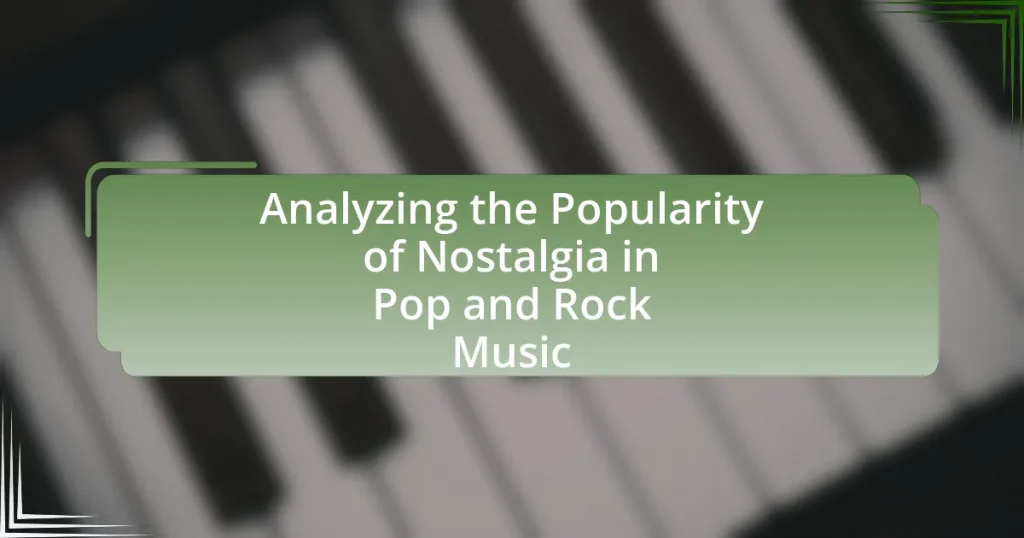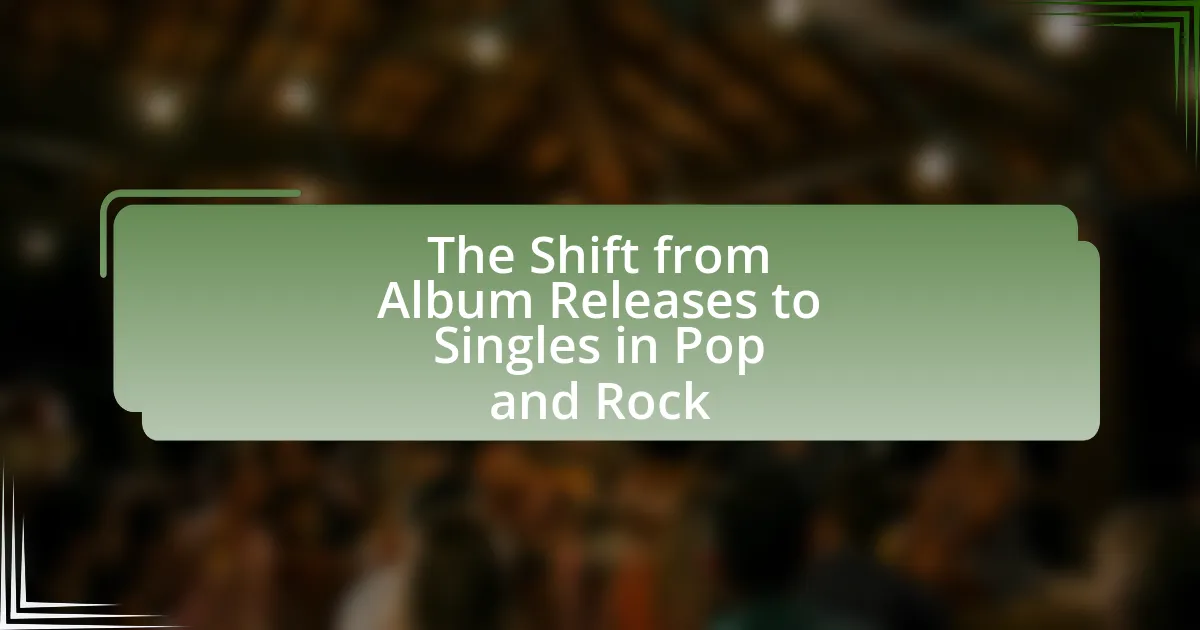The article examines the significant role of nostalgia in pop and rock music, highlighting how it evokes emotional connections to the past, enhances listener engagement, and drives commercial success. It discusses the influence of nostalgia on music creation, including key elements in songwriting, the incorporation of retro sounds and themes, and the psychological effects on listeners. Additionally, the article explores how societal changes and cultural factors contribute to the prevalence of nostalgia in contemporary music, as well as its impact on marketing strategies and music industry trends. Through various examples and research findings, the article illustrates how nostalgia shapes music preferences and influences both established and emerging artists in the industry.
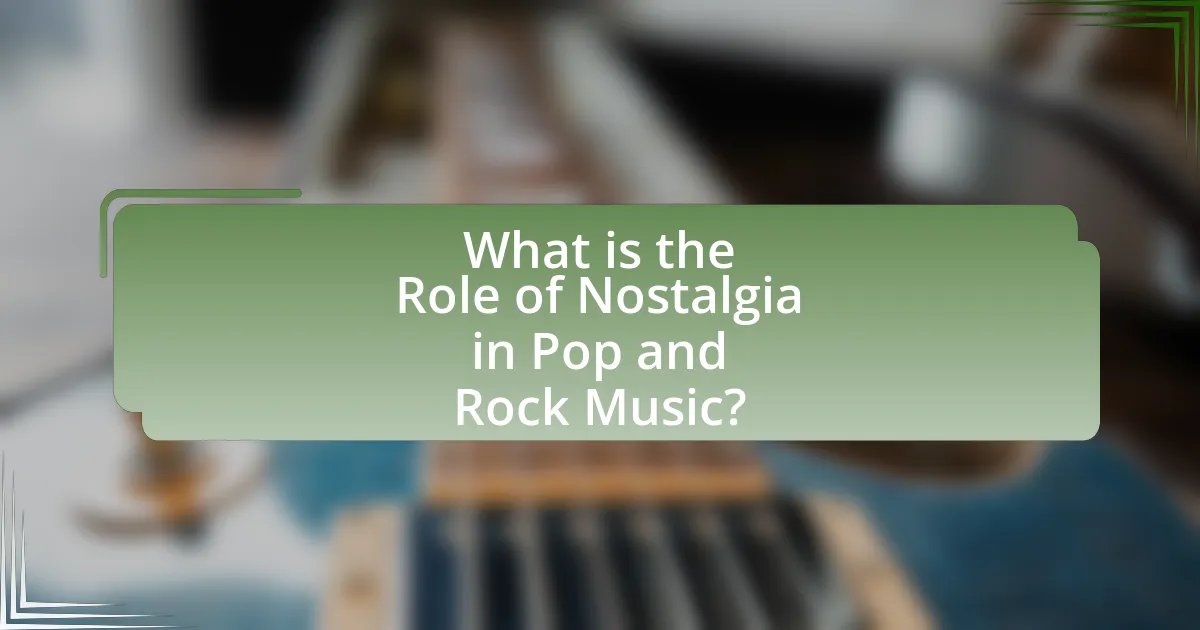
What is the Role of Nostalgia in Pop and Rock Music?
Nostalgia plays a significant role in pop and rock music by evoking emotional connections to the past, which enhances listener engagement and drives commercial success. This emotional resonance is often achieved through the use of familiar sounds, themes, and references that remind audiences of earlier musical eras or personal memories. For instance, artists like Taylor Swift and Bruno Mars have successfully incorporated retro styles and lyrical themes that harken back to previous decades, tapping into listeners’ fond memories and creating a sense of comfort. Research indicates that nostalgia can increase the enjoyment of music, as evidenced by a study published in the journal “Psychology of Music,” which found that nostalgic songs elicit positive emotions and enhance the overall listening experience.
How does nostalgia influence the creation of music in these genres?
Nostalgia significantly influences the creation of music in pop and rock genres by evoking emotional connections to past experiences, which artists often leverage to resonate with audiences. This emotional appeal is evident in the use of retro sounds, familiar melodies, and lyrical themes that reflect past cultural moments, allowing listeners to relive cherished memories. For instance, the resurgence of 1980s synth-pop elements in contemporary tracks illustrates how artists tap into nostalgia to create a sense of familiarity and comfort, enhancing listener engagement. Research indicates that nostalgic music can trigger positive emotions and increase the likelihood of repeated listening, as demonstrated in studies published in the Journal of Consumer Research, which highlight nostalgia’s role in consumer behavior and emotional responses to music.
What are the key elements of nostalgia in songwriting?
The key elements of nostalgia in songwriting include evocative imagery, personal memories, and cultural references. Evocative imagery allows listeners to visualize past experiences, while personal memories create an emotional connection to the song. Cultural references, such as specific events, trends, or icons from a particular era, anchor the song in a shared history, enhancing its nostalgic appeal. Research indicates that nostalgia can trigger positive emotions and a sense of belonging, making songs that incorporate these elements resonate deeply with audiences.
How do artists incorporate nostalgic themes into their music?
Artists incorporate nostalgic themes into their music by utilizing familiar sounds, lyrical references, and cultural motifs from past decades. For instance, many contemporary pop and rock songs feature retro instrumentation, such as synthesizers reminiscent of the 1980s, which evoke a sense of longing for that era. Additionally, artists often reference specific cultural icons, events, or personal memories in their lyrics, creating a connection with listeners who share similar experiences. Research indicates that nostalgia can enhance emotional engagement, making songs more relatable and memorable, as seen in the success of tracks that sample older music or pay homage to past styles.
Why has nostalgia become a prevalent theme in recent pop and rock music?
Nostalgia has become a prevalent theme in recent pop and rock music due to a collective longing for simpler times and the emotional resonance associated with past experiences. This trend is evidenced by the resurgence of musical styles and cultural references from the 1980s and 1990s, as artists like Dua Lipa and The Weeknd incorporate retro sounds and aesthetics into their work. Additionally, studies indicate that nostalgia can evoke positive emotions and enhance listeners’ connection to music, making it a powerful tool for artists aiming to engage audiences. The popularity of nostalgic elements is further supported by the success of albums and singles that draw on past influences, demonstrating a clear market demand for this thematic approach in contemporary music.
What cultural factors contribute to the rise of nostalgia in music?
Cultural factors contributing to the rise of nostalgia in music include the cyclical nature of trends, the impact of social media, and collective memory. The cyclical nature of trends in music often leads to the revival of past styles, as seen in the resurgence of 1980s synth-pop and 1990s grunge in contemporary music. Social media platforms facilitate the sharing of nostalgic content, allowing users to connect over shared memories and experiences, which amplifies the emotional resonance of older music. Additionally, collective memory, shaped by significant historical events and cultural milestones, influences listeners’ preferences, as music often serves as a soundtrack to personal and societal experiences. For instance, studies show that music from one’s formative years tends to evoke stronger emotional responses, reinforcing nostalgia’s role in music consumption.
How do societal changes impact the nostalgic elements in music?
Societal changes significantly influence the nostalgic elements in music by shaping the themes, styles, and references that resonate with listeners. For instance, during periods of economic hardship, such as the Great Depression, music often reflected longing for simpler times, as seen in folk and blues genres. Similarly, the rise of digital technology has led to a resurgence of 1980s and 1990s sounds in contemporary pop, as artists like Dua Lipa and The Weeknd incorporate retro synths and production techniques, appealing to listeners’ nostalgia for that era. Research indicates that nostalgia in music can enhance emotional connections, with studies showing that nostalgic songs can evoke memories and feelings of belonging, particularly during times of social upheaval or change. This connection between societal context and musical nostalgia illustrates how artists adapt their work to reflect collective memories and sentiments, reinforcing the relevance of nostalgic elements in music.
What psychological effects does nostalgia have on listeners?
Nostalgia has a significant psychological effect on listeners, primarily inducing feelings of happiness and comfort. Research indicates that nostalgia can enhance mood, increase feelings of social connectedness, and provide a sense of continuity in life. A study published in the journal “Emotion” by Wildschut et al. (2006) found that nostalgic memories often evoke positive emotions and can counteract feelings of loneliness and anxiety. This emotional uplift is attributed to nostalgia’s ability to remind individuals of cherished experiences and relationships, reinforcing a sense of identity and belonging.
How does nostalgia enhance emotional connections to music?
Nostalgia enhances emotional connections to music by triggering memories and feelings associated with past experiences. When individuals listen to music that evokes nostalgia, it activates the brain’s reward system, releasing dopamine, which intensifies emotional responses. Research indicates that nostalgic music can lead to increased feelings of social connectedness and well-being, as it often reminds listeners of significant life events or relationships. A study published in the journal “Psychology of Music” by Janata et al. (2007) found that nostalgic music can evoke vivid memories and emotions, reinforcing the bond between the listener and the music.
What role does nostalgia play in shaping music preferences?
Nostalgia significantly influences music preferences by evoking emotional connections to past experiences and memories. This emotional resonance often leads individuals to favor music that reminds them of specific moments in their lives, such as adolescence or significant life events. Research indicates that nostalgic music can trigger dopamine release, enhancing pleasure and reinforcing the desire to revisit those songs. A study published in the journal “Psychology of Music” by Wildschut et al. (2006) found that nostalgia can increase feelings of social connectedness and improve mood, further solidifying its role in shaping music preferences. Thus, nostalgia acts as a powerful mechanism that not only influences individual choices but also drives the popularity of certain genres, particularly in pop and rock music.
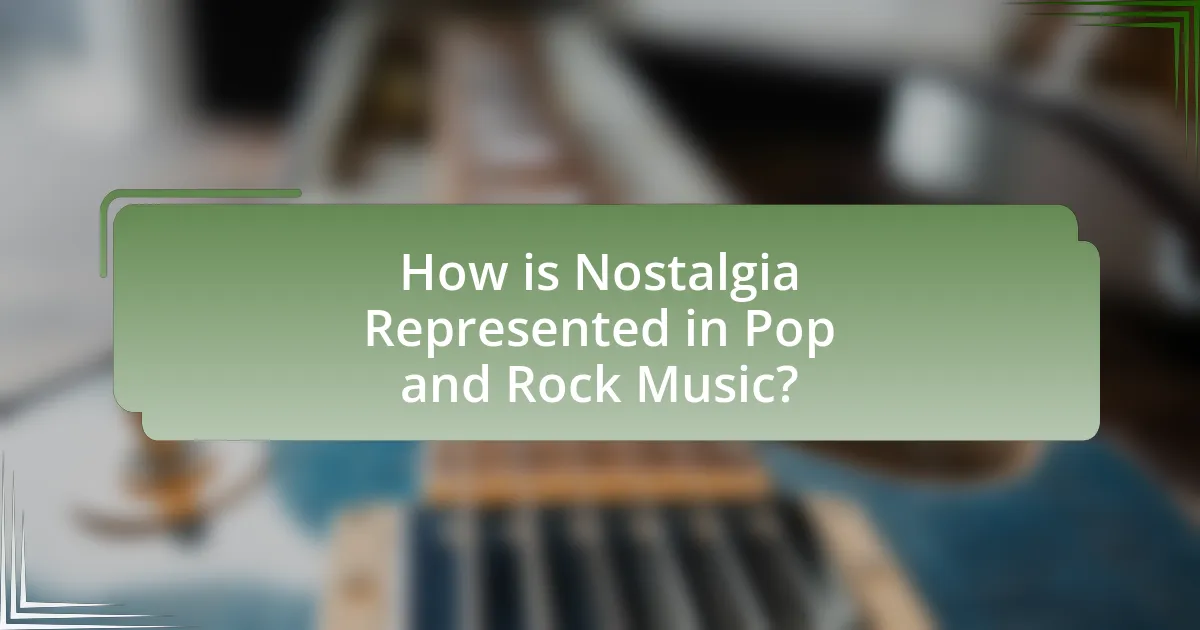
How is Nostalgia Represented in Pop and Rock Music?
Nostalgia in pop and rock music is represented through lyrical themes, musical styles, and cultural references that evoke memories of past eras. Artists often incorporate elements from previous decades, such as 1980s synth sounds or 1990s grunge aesthetics, to create a sense of familiarity and emotional connection. For example, songs like “Summer of ’69” by Bryan Adams and “1979” by The Smashing Pumpkins explicitly reference specific years, triggering listeners’ memories of their own experiences. Additionally, the resurgence of vinyl records and retro music videos highlights a cultural trend where both genres celebrate and romanticize the past, reinforcing nostalgia as a powerful emotional tool in music.
What are the common musical styles that evoke nostalgia?
Common musical styles that evoke nostalgia include classic rock, doo-wop, and folk music. Classic rock, characterized by its guitar-driven sound and anthemic melodies, often brings back memories of the 1960s and 1970s, a period marked by significant cultural shifts. Doo-wop, with its harmonious vocal arrangements and simple lyrics, is reminiscent of the 1950s and is frequently associated with themes of young love and innocence. Folk music, rooted in storytelling and acoustic instrumentation, often evokes a sense of longing for simpler times and traditional values, connecting listeners to their cultural heritage. These styles are effective in eliciting nostalgic feelings due to their historical significance and emotional resonance with listeners.
How do specific genres utilize nostalgic sounds and techniques?
Specific genres like pop and rock utilize nostalgic sounds and techniques by incorporating elements from past musical eras, such as vintage instrumentation, production styles, and lyrical themes. For instance, pop music often employs synthesizers reminiscent of the 1980s, creating a retro sound that appeals to listeners’ memories of that time. Rock music frequently revisits classic guitar riffs and analog recording techniques, evoking the raw energy of earlier decades. This approach is supported by studies indicating that nostalgia can enhance emotional engagement, making songs more relatable and memorable for audiences.
What instruments or production methods are often associated with nostalgic music?
Instruments and production methods often associated with nostalgic music include vintage synthesizers, acoustic guitars, and analog recording techniques. Vintage synthesizers, such as the Roland Juno-106, evoke sounds reminiscent of the 1980s, while acoustic guitars provide a warm, organic quality that recalls earlier musical eras. Analog recording techniques, including tape saturation and the use of reel-to-reel machines, contribute to a lo-fi aesthetic that many listeners associate with nostalgia. These elements are frequently employed by contemporary artists to create a sense of familiarity and emotional resonance, tapping into collective memories of past musical styles.
How do lyrics reflect nostalgic themes in pop and rock songs?
Lyrics in pop and rock songs often reflect nostalgic themes by evoking memories of past experiences, relationships, and cultural moments. This is achieved through specific imagery, references to historical events, and emotional language that resonates with listeners’ personal histories. For example, songs like “Summer of ’69” by Bryan Adams and “We Are Young” by Fun. utilize vivid storytelling and relatable scenarios that transport listeners back to significant times in their lives. Research indicates that nostalgia in music can enhance emotional connections, as demonstrated in a study published in the Journal of Consumer Research, which found that nostalgic songs can increase feelings of social connectedness and well-being. Thus, the lyrics serve as a powerful vehicle for nostalgia, allowing artists to connect deeply with their audience by tapping into shared memories and sentiments.
What storytelling techniques are used to convey nostalgia in lyrics?
Storytelling techniques used to convey nostalgia in lyrics include vivid imagery, personal anecdotes, and temporal contrasts. Vivid imagery evokes specific memories and emotions, allowing listeners to visualize past experiences, while personal anecdotes create a relatable connection to shared moments. Temporal contrasts highlight the differences between past and present, emphasizing change and loss, which deepens the sense of nostalgia. For example, songs like “Summer of ’69” by Bryan Adams utilize these techniques to evoke feelings of longing for simpler times, illustrating how effective storytelling can resonate emotionally with audiences.
How do artists reference past cultural moments in their music?
Artists reference past cultural moments in their music by incorporating specific historical events, cultural symbols, and stylistic elements that evoke nostalgia. For example, musicians often use lyrical references to significant social movements, such as civil rights or counterculture, to connect with listeners’ shared memories and experiences. Additionally, they may sample or mimic musical styles from previous decades, such as the use of 1980s synth-pop sounds in contemporary tracks, which creates a sense of familiarity and emotional resonance. This practice is supported by research indicating that nostalgia can enhance emotional engagement and listener satisfaction, as seen in studies published in journals like “Psychology of Music.”
What visual elements accompany nostalgic music in pop and rock?
Visual elements that accompany nostalgic music in pop and rock include retro aesthetics, vintage fashion, and imagery that evokes past decades. These elements often feature color palettes reminiscent of the 70s, 80s, or 90s, such as pastel colors or sepia tones, which enhance the feeling of nostalgia. Additionally, music videos may incorporate archival footage, old-school graphics, and references to cultural icons from previous eras, reinforcing the nostalgic theme. For instance, artists like Taylor Swift and Bruno Mars utilize these visual cues in their music videos to evoke memories associated with earlier times, effectively connecting with audiences who have a fondness for those periods.
How do music videos and album art enhance nostalgic themes?
Music videos and album art enhance nostalgic themes by visually representing and evoking memories associated with specific eras, styles, or cultural moments. These visual elements often incorporate retro aesthetics, familiar imagery, and references to past trends, which resonate with audiences’ personal experiences and collective memory. For instance, music videos that feature vintage fashion, classic cars, or iconic locations can trigger nostalgia by reminding viewers of their own past or a romanticized version of history. Additionally, album art that employs design styles from previous decades, such as 80s neon graphics or 70s psychedelic patterns, reinforces these themes by creating a visual connection to the music’s emotional context. This strategic use of visuals not only enhances the listening experience but also deepens the emotional impact of the music, making it more relatable and memorable for audiences.
What role does fashion play in the nostalgia of music culture?
Fashion plays a crucial role in the nostalgia of music culture by serving as a visual representation of specific eras and movements within the music scene. The clothing styles associated with iconic musicians and genres, such as the bell-bottoms of the 1970s rock scene or the punk attire of the late 1970s and early 1980s, evoke memories and emotions tied to those times. This connection is reinforced by the way fashion trends often reflect the cultural and social dynamics of their respective periods, making them integral to the identity of musical genres. For instance, the resurgence of 90s grunge fashion in contemporary music reflects a longing for the authenticity and rebellion of that era, illustrating how fashion can trigger collective memories and sentiments associated with music.
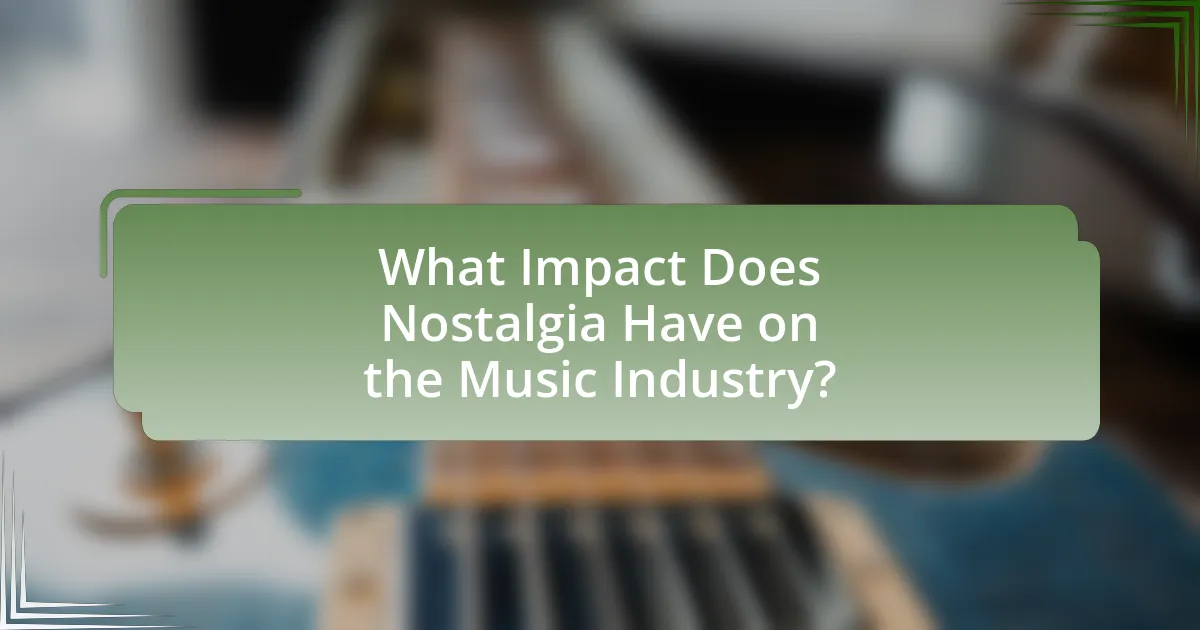
What Impact Does Nostalgia Have on the Music Industry?
Nostalgia significantly influences the music industry by driving consumer engagement and shaping marketing strategies. This emotional connection to past music eras encourages artists and producers to revive classic sounds and styles, leading to increased sales and streaming of nostalgic tracks. For instance, a study by the University of Southern California found that nostalgic songs often evoke strong emotional responses, which can enhance listener loyalty and increase the likelihood of sharing music on social media platforms. Additionally, the resurgence of vinyl records and retro-themed concerts highlights the commercial viability of nostalgia, as evidenced by a 2020 report from the Recording Industry Association of America, which noted a 29% increase in vinyl sales, largely attributed to consumers seeking a tangible connection to their musical past.
How does nostalgia influence music marketing and promotion?
Nostalgia significantly influences music marketing and promotion by leveraging emotional connections to past experiences, which enhances consumer engagement. Marketers often utilize nostalgic themes in advertising campaigns, tapping into the audience’s fond memories associated with specific songs or artists. For instance, studies show that nostalgia can increase brand attachment and consumer loyalty, as evidenced by a 2015 study published in the Journal of Consumer Research, which found that nostalgic music can evoke positive emotions and increase willingness to purchase related products. This strategy is particularly effective in pop and rock music, where artists frequently reference past eras in their work, creating a sense of familiarity that resonates with audiences.
What strategies do record labels use to capitalize on nostalgia?
Record labels capitalize on nostalgia by reissuing classic albums, leveraging anniversary editions, and promoting legacy artists. Reissuing classic albums allows labels to tap into the existing fan base while attracting new listeners, as seen with the 50th anniversary reissue of The Beatles’ “Abbey Road,” which generated significant sales and streaming numbers. Anniversary editions often include previously unreleased tracks and enhanced packaging, creating a sense of exclusivity and appeal. Additionally, promoting legacy artists through tours and collaborations with contemporary musicians helps maintain relevance and engage both older and younger audiences, exemplified by the resurgence of artists like Fleetwood Mac and their successful tours in recent years.
How do nostalgia-driven trends affect music sales and streaming?
Nostalgia-driven trends significantly boost music sales and streaming by tapping into consumers’ emotional connections to past eras. This phenomenon is evidenced by the resurgence of vinyl records, which saw sales increase to 41 million units in 2020, the highest since 1986, according to the Recording Industry Association of America. Additionally, streaming platforms report that playlists featuring nostalgic hits from the 80s and 90s consistently rank among the most popular, driving engagement and subscriptions. The emotional resonance of nostalgia not only enhances listener loyalty but also encourages the discovery of older music, leading to increased revenue for artists and labels alike.
What are the implications of nostalgia for new artists in pop and rock?
Nostalgia significantly influences new artists in pop and rock by shaping their creative direction and audience engagement strategies. This emotional connection to the past allows artists to evoke familiar sounds and aesthetics, which can enhance their appeal to both older and younger audiences. For instance, the resurgence of 1980s synth-pop elements in contemporary music has led to chart-topping hits, demonstrating how nostalgia can drive commercial success. Additionally, studies show that nostalgic music often elicits positive emotions, which can foster a loyal fan base and increase streaming numbers. Therefore, new artists leveraging nostalgia can effectively navigate the competitive landscape of the music industry while resonating with listeners’ memories and emotions.
How can emerging artists leverage nostalgia to build their brand?
Emerging artists can leverage nostalgia to build their brand by incorporating familiar sounds, visuals, and themes from past decades into their music and marketing strategies. This approach taps into the emotional connections that audiences have with their memories, making the artists more relatable and appealing. For instance, artists like Dua Lipa have successfully utilized retro aesthetics and sounds reminiscent of the 1980s, which has contributed to her widespread popularity and commercial success. By evoking nostalgia, artists can create a sense of familiarity that resonates with listeners, leading to increased engagement and loyalty.
What challenges do new artists face when competing with nostalgic acts?
New artists face significant challenges when competing with nostalgic acts, primarily due to established fan bases and emotional connections that nostalgic acts have cultivated over time. These established artists often evoke strong memories and sentiments, making it difficult for new artists to capture the same level of attention and loyalty. According to a study by the University of Southern California, nostalgia can enhance consumer preferences, leading audiences to favor familiar music over new releases. Additionally, new artists often struggle with limited marketing budgets and resources compared to the extensive promotional support that nostalgic acts receive from record labels and media. This disparity in visibility further complicates the ability of new artists to gain traction in a market dominated by well-known names.
What are the best practices for incorporating nostalgia in music creation?
The best practices for incorporating nostalgia in music creation include using familiar musical elements, referencing past genres, and evoking specific memories through lyrics. Familiar musical elements, such as chord progressions or instrumentation reminiscent of earlier decades, can trigger nostalgic feelings in listeners. For example, the use of 1980s synth sounds in contemporary pop music often evokes a sense of nostalgia for that era. Referencing past genres, like incorporating classic rock riffs or Motown rhythms, can also connect with listeners’ memories. Additionally, crafting lyrics that evoke specific cultural or personal memories, such as summer romances or childhood experiences, can deepen the nostalgic impact. Research indicates that nostalgia can enhance emotional engagement, making music more relatable and memorable, as shown in studies by Batcho (1995) and Wildschut et al. (2006), which highlight nostalgia’s role in emotional well-being and social connectedness.
How can artists balance originality with nostalgic influences?
Artists can balance originality with nostalgic influences by integrating contemporary elements with familiar motifs from the past. This approach allows them to create innovative works that resonate with audiences while evoking a sense of nostalgia. For instance, many successful pop and rock artists, such as Dua Lipa and The Weeknd, have incorporated retro sounds and styles into their music, blending them with modern production techniques. This strategy not only honors the influences of previous eras but also ensures that the final product feels fresh and relevant to current listeners. By carefully selecting which nostalgic elements to incorporate and pairing them with original ideas, artists can effectively navigate the tension between homage and innovation.
What tips can musicians follow to effectively evoke nostalgia in their work?
Musicians can effectively evoke nostalgia in their work by incorporating familiar melodies, using vintage instrumentation, and referencing cultural touchstones from the past. Familiar melodies can trigger memories and emotions associated with specific times, as studies show that music is closely linked to personal memories. Utilizing vintage instrumentation, such as analog synthesizers or classic guitar tones, can create a sound reminiscent of earlier musical eras, appealing to listeners’ sense of nostalgia. Additionally, referencing cultural touchstones, like iconic lyrics or themes from past decades, can further enhance the nostalgic experience, as these elements resonate with listeners’ shared memories and experiences.
